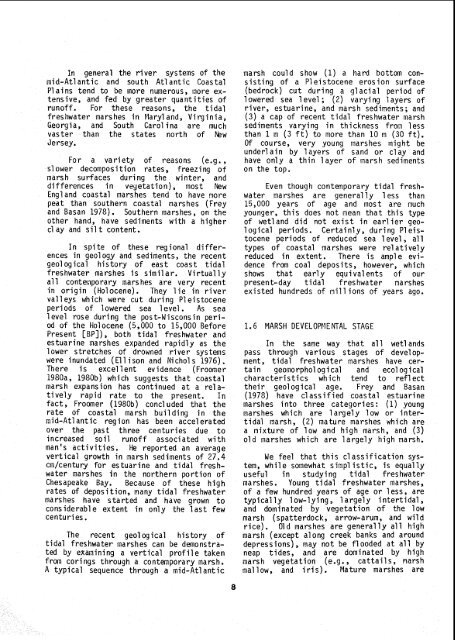The Ecology of Tidal Freshwater Marshes of the - USGS National ...
The Ecology of Tidal Freshwater Marshes of the - USGS National ...
The Ecology of Tidal Freshwater Marshes of the - USGS National ...
Create successful ePaper yourself
Turn your PDF publications into a flip-book with our unique Google optimized e-Paper software.
In general <strong>the</strong> river systems <strong>of</strong> <strong>the</strong>mid-At1 antic and south At1 antic CoastalPi ai ns tend to be more numerous, more extensive,and fed by greater quantities <strong>of</strong>run<strong>of</strong>f. For <strong>the</strong>se reasons, <strong>the</strong> tidalfreshwater marshes in f,laryl and, Virginia,Georgia, and South Carolina are muchvaster than <strong>the</strong> states north <strong>of</strong> NewJersey.For a variety <strong>of</strong> reasons (e.g.,sl ower decomposition rates, freezing <strong>of</strong>marsh surfaces during <strong>the</strong> winter, anddifferences in vegetation), most NewEngland coastal marshes tend to have morepeat than sou<strong>the</strong>rn coastal marshes (Freyand Basan 1978). Sou<strong>the</strong>rn marshes, on <strong>the</strong>o<strong>the</strong>r hand, have sediments with a highercl ay and silt content.In spite <strong>of</strong> <strong>the</strong>se regional differencesin geology and sediments, <strong>the</strong> recentgeological history <strong>of</strong> east coast tidalfreshwater marshes is similar. Virtuallyall conteinporary marshes are very recentin origin (Holocene). <strong>The</strong>y lie in rivervall eys which were cut during Pleistoceneperiods <strong>of</strong> lowered sea level. As sealevel rose during <strong>the</strong> post-Wisconsin period<strong>of</strong> <strong>the</strong> Holocene (5,000 to 15,000 BeforePresent [BPI), both tidal freshwater andestuarine marshes expanded rapidly as <strong>the</strong>lower stretches <strong>of</strong> drowned river systemswere inundated (El 1 i son and Nichol s 1976).<strong>The</strong>re is excel lent evidence (Froomer1980a, 1980b) which suggests that coastalmarsh expansion has continued at a relativelyrapid rate to <strong>the</strong> present. Infact, Froomer (1980b) concluded that <strong>the</strong>rate <strong>of</strong> coastal marsh building in <strong>the</strong>mid-At1 antic reg ion has been accel eratedover <strong>the</strong> past three centuries due toincreased soil run<strong>of</strong>f associated withman's activities. He reported an averagevertical growth in marsh sediments <strong>of</strong> 27.4cmlcentury for estuarine and tidal freshwatermarshes in <strong>the</strong> nor<strong>the</strong>rn portion <strong>of</strong>Chesapeake Bay. Because <strong>of</strong> <strong>the</strong>se highrates <strong>of</strong> deposition, many tidal freshwatermarshes have started and have grown toconsiderable extent in only <strong>the</strong> last fewcenturies.<strong>The</strong> recent geological history <strong>of</strong>tidal freshwater marshes can be demonstratedby examining a vertical pr<strong>of</strong>ile takenfrom corings through a contemporary marsh.A typical sequence through a mid-At1 anticmarsh could show (1) a hard bottom consisting<strong>of</strong> a Pleistocene erosion surface(bedrock) cut during a glacial period <strong>of</strong>lowered sea 1 evel ; (2) varying layers <strong>of</strong>river, estuarine, and narsh sediments; and(3) a cap <strong>of</strong> recent tidal freshwater marshsediments varying in thickness from lessthan 1 m (3 ft) to more than 10 m (30 ft).Of course, very young marshes might beunderlain by layers <strong>of</strong> sand or clay andhave only a thin 1 ayer <strong>of</strong> narsh sedimentson <strong>the</strong> top.Even though contemporary tidal freshwatermarshes are generally 1 ess than15,000 years <strong>of</strong> age and most are nuchyounger, this does not nean that this type<strong>of</strong> wetland did not exist in earlier geologicalperiods. Certainly, during Pleistoceneperiods <strong>of</strong> reduced sea 1 evel, alltypes <strong>of</strong> coastal marshes were relativelyreduced in extent. <strong>The</strong>re is ample evidencefrom coal deposits, however, whichshows that early equivalents <strong>of</strong> ourpresent-day tidal freshwater marshesexisted hundreds <strong>of</strong> mill ions <strong>of</strong> years ago.1.6 MARSH DEVELOPMENTAL STAGEIn <strong>the</strong> same way that all wet1 andspass through various stages <strong>of</strong> development,tidal freshwater marshes have certain geomorphol og i cal and ecol og i calcharacteristics which tend to ref1 ect<strong>the</strong>ir geological age. Frey and Basan(1978) have cl assif ied coastal estuarinemarshes into three categories: (1) youngmarshes which are largely low or intertidalmarsh, (2) mature marshes which area mixture <strong>of</strong> low and high marsh, and (3)old marshes which are largely high marsh.We feel that this classification system,while somewhat simp1 istic, is equallyuseful in studying tidal freshwatermarshes. Young tidal freshwater marshes,<strong>of</strong> a few hundred years <strong>of</strong> age or 1 ess, aretypically low-lying, largely intertidal,and dominated by vegetation <strong>of</strong> <strong>the</strong> lowmarsh (spatterdock, arrow-arum, and wildrice). Old marshes are generally all highmarsh (except along creek banks and arounddepressions), may not be flooded at all byneap tides, and are dominated by highmarsh vegetation (e.g., cattails, marshmallow, and iris). Mature marshes are

















